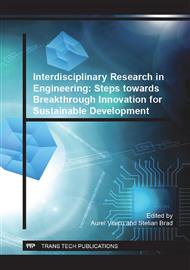[1]
S. Malassiotis, F. Tsalakanidou, N. Mavridis, V. Giagourta, N. Grammalidis, M. G Strintzis, A face and gesture recognition system based on an active stereo sensor, Proceedings 2001 ICIP, 3 (2001) 955–958.
DOI: 10.1109/icip.2001.958283
Google Scholar
[2]
M. Bray, Koller-Meier, L. V Gool, Smart particle filtering for 3D hand tracking, Sixth IEEE International Conference on Automatic Face and Gesture Recognition, (2004), 675-680.
DOI: 10.1109/afgr.2004.1301612
Google Scholar
[3]
P. Breuer, C. Eckes, S Muller, Hand Gesture Recognition with a novel IR Time-of-Flight Range Camera - A pilot study, Computer Vision / Computer Graphics Collaboration Techniques and Applications, (2007) 247–260.
DOI: 10.1007/978-3-540-71457-6_23
Google Scholar
[4]
E. Kollorz, J. Penne, J. Hornegger, A. Barke, Gesture recognition with a time-of-flight camera. Int. J. Intell. Syst. Technol. Appl. 5(3/4), (2008) 334–343.
DOI: 10.1504/ijista.2008.021296
Google Scholar
[5]
J. Molina, M. Escudero-Viñolo, A. Signoriello, M. Pardás, C. Ferrán, J. Bescós, F. Marqués, J. Martínez, Real-time user independent hand gesture recognition from time-of-flight camera video using static and dynamic models. Machine Vision and Applications (2011).
DOI: 10.1007/s00138-011-0364-6
Google Scholar
[6]
Information on http: /www. microchip. com/pagehandler/en-us/press-release/microchips-new-gestic-technolo. html.
Google Scholar
[7]
B. Ommer, J.M. Buhmann , Learning the Compositional Nature of Visual, CVPR'07, IEEE, (2007).
Google Scholar
[8]
B. Ommer, J.M. Buhmann, Learning Compositional Categorization Models Objects ECCV'06, LNCS 3953, Springer, (2006).
Google Scholar
[9]
Li Fei-Fei, Pietro Perona A Bayesian Hierarchical Model for Learning Natural Scene Categories , EEE Comp. Vis. Patt. Recog. ( 2005).
DOI: 10.1109/cvpr.2005.16
Google Scholar
[10]
A. Oikonomopoulos, I. Patras, M. Pantic, Spatiotemporal Salient Points for Visual Recognition of Human Actions, Ieee Transactions On Systems, Man, And Cybernetics—Part B: Cybernetics, 36, (2006).
DOI: 10.1109/tsmcb.2005.861864
Google Scholar
[11]
I. Laptev, T. Lindeberg, Space-time Interest Points, Proceedings of the Ninth IEEE International Conference on Computer Vision, (2003).
DOI: 10.1109/iccv.2003.1238378
Google Scholar
[12]
J. Canny, Finding edges and lines in images, Tehnical Reoprt AITR-720, Massachusetts Institute of Technologie, (1983).
Google Scholar
[13]
J. Canny, A computational approach to edge detection, IEEE Transactions on Pattern Analysis and Machine Intelligence, 8(1986) 679–698.
DOI: 10.1109/tpami.1986.4767851
Google Scholar
[14]
Information on http: /www. ai. sri. com/pubs/files/tn036-duda71. pdf.
Google Scholar


